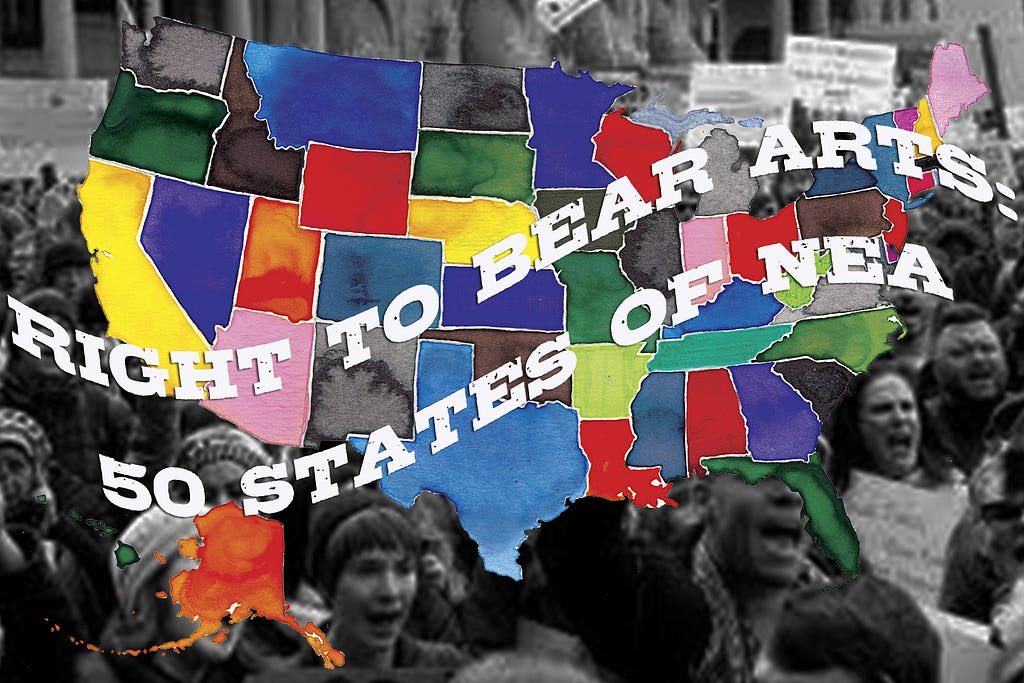
Like many of us, I was appalled at the announcement that the “America First” Budget Blueprint would not only cut but eliminate four independent cultural agencies — the National Endowment for the Arts, the National Endowment for the Humanities, the Institute of Museum and Library Services, and the Corporation for Public Broadcasting.
It doesn’t take long to realise that any spin around these cuts having primarily financial motivation is utterly nonsensical. This is a battle call against cultural and social freedoms, and against the mediums in which free speech and free thinking is encouraged and nurtured. So, too, is it based on the rhetorics of anti-intellectualism, and on the illusion of these monies supporting primarily elite institutions and persons.
So, I set out to debunk this fallacy, going state by state to highlight the vitally important work being done by NEA funded institutions — as well as to amplify the visibility of the intersectional communities they serve. (You can read the introduction to the series here.) We began with Alaska, and today, we’re headed down south, to Alabama.
I’ve spent little time in the South, and I’ve never been to Alabama. How much do you know about the state? Since we’re talking about elitism and questions of privilege, lets talk a little about the state itself. Alabama is the 4th poorest state in the US, with around 20 percent of its population living below the poverty level, and a college attainment rate is just over 30%. The state is home to just around 5 million people for its 52,000 square miles.(In comparison, over 27,000 people per square mile live in NYC.)
Alabama remains a deeply segregated state, continuing to battle long-term disenfranchisement and the fallout of confederate sentiment. Its state population is just over 70% White, with 26% African American residents — percentages that flip in many of its urban areas in particular.
While one might presume that arts funding here might be reinforcing the race, educational, and class divides, supporting those already benefitting from the state’s few resources — you’d be very mistaken. These institutions support folk arts, education, music writing, and prison initiatives, serving diverse and underserved communities — offering resources, opportunities, and outlets to everyone from children to seniors.
The first institutions we’ll focus on are based in Birmingham, a city boasting around 250,000 residents (within a metro area of over a million), 73% of whom are African American.
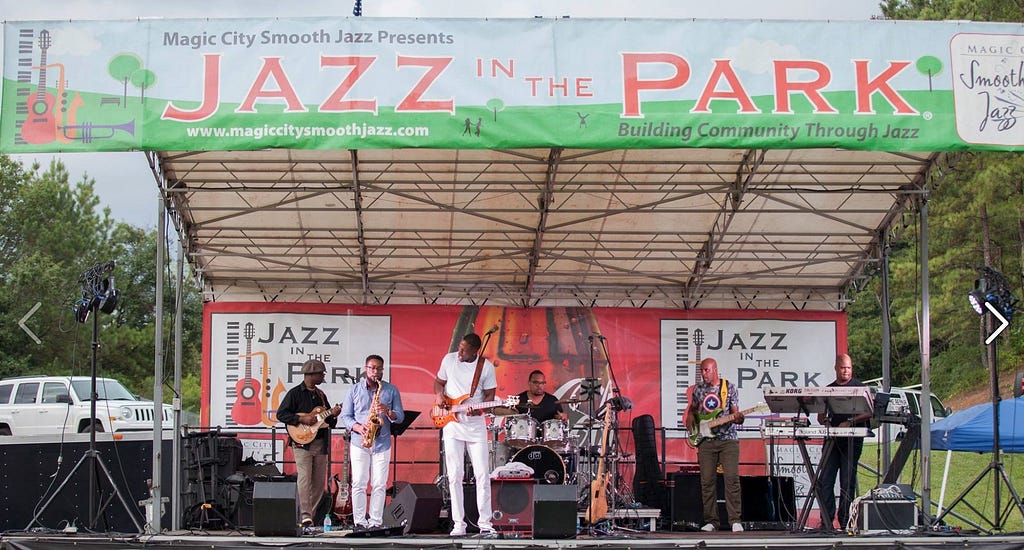
Magic City Smooth Jazz, our first recipient, is an organization founded in 2008 with a mission “to expose and engage audiences in culturally underserved communities in the state of Alabama to various styles of jazz at no cost.” Funds went directly to their Jazz in the Park program, increasing opportunities for residents to experience arts and culture closer to their homes.
Next we have The Alabama Folklife Association, recipient of an NEA grant to support Alabama Makers: Discovery and Showcase. These funds allowed folklorists to conduct fieldwork identifying and documenting local folk artists, whose work is all to often lost to the archive. Working specifically to counter that, this documentation will be deposited in the Archive of Alabama Folk Culture at the Alabama Department of Archives and History. While the organization is technically based in Birmingham, this work has broader impact, with programming supporting these folk artists — including musicians, storytellers, and crafts people - presenting public concerts, demonstrations, and exhibits throughout the state.
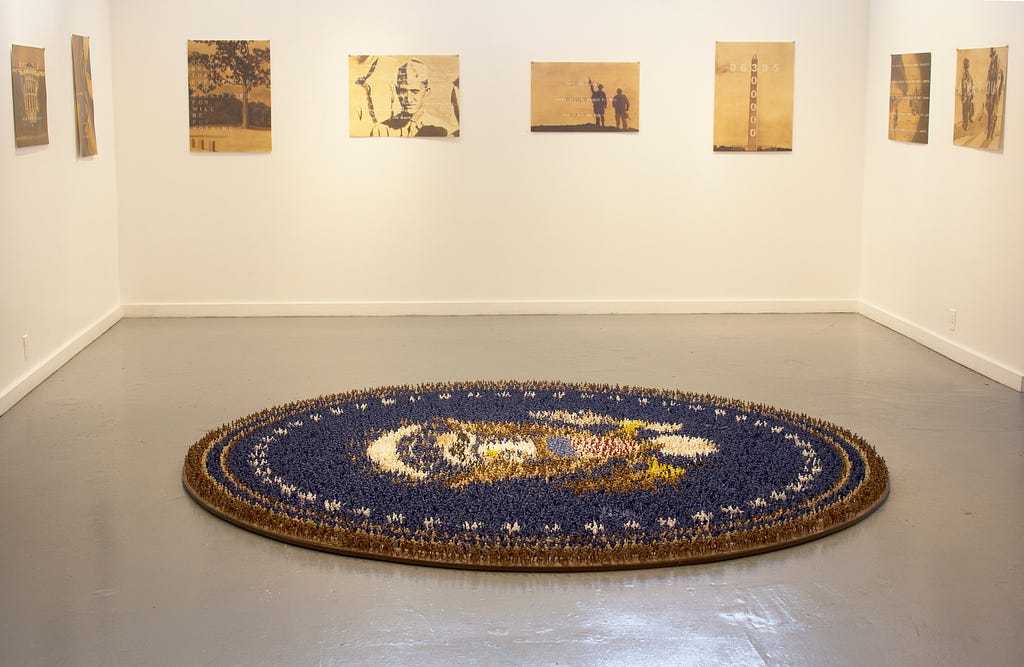
Birmingham based arts organization Space One Eleven, founded in 1986 with the mission “to educate the community of the role of artists and art in the public sphere,” received NEA funds to support the Cost of Living project, a series of events, exhibitions, and residencies examining issues related to income inequality. An anchor exhibition for the program will feature artist Larry Thompson’s Infrantree Project, examining the impact of recent military conflicts on civilians, veterans, and their families. These artists will be joined by an exhibition from ceramist and Gulf War veteran artist, former Marine Corps Ehren Tool, and installation artist Aisha Tandiwe Bell.
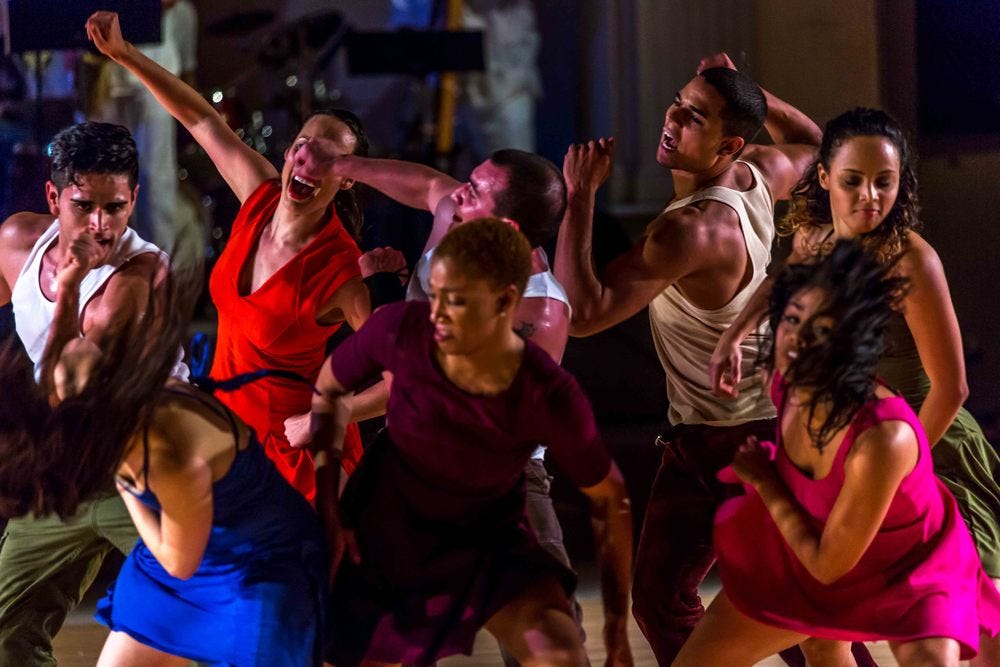
The Alabama Dance Council and the University of Alabama at Birmingham both received grant monies to bring world-class dance companies — and, in particular, outstanding dancers of color — to the state for both performance and teaching opportunities.
The Alabama Dance Council has been providing dance based programming across the state for over 35 years. Funding this year went to support the 20th anniversary of the Alabama Dance Festival, featuring performances and a residency by Urban Latin Dance Theatre company CONTRA-TIEMPO. The festival also features new work from Southern choreographers, showcases from regional dance companies, master classes, workshops, community classes, and a Dance for Schools program. The CONTRA-TIEMPO residency specifically centers around the company’s new work “Agua Furiosa” which incorporates local stories into its production.
Companies presented by U Alabama with NEA support include Alvin Ailey American Dance Theater, MOMIX, and Ballet Hispanico, all presenting public performances and substantial community engagement activities.
And while it might appear that an institute of higher education receiving funds keeps it from the general population, this is far from the truth in the state; the fact is that the University System is highly tied to cultural production and presentation in many cities in Alabama. Schools were often built in an effort to revitalize local economies in severely depressed areas, and thereby serve as hubs for not only the school’s population but indeed for everyone in these districts.
As in many states, on the chopping block with a threat to NEA funding is public media. In this cycle, funds went to support Alabama Public Television, specifically for “Journey Proud IV,” a television series documenting Alabama traditions. The program presents folk arts and cultural traditions, and includes Web-based resources for educators.
Let’s move on to Montgomery Alabama, a place you probably associate most with civil rights actions, and rightly so. Still largely segregated in its residential patterns, this is now one of the state’s cities most balanced in its racial composition, with 56% African American residents, 33% white, and a small percentile of other races.

In Montgomery we find the long-running Alabama Shakespeare festival, founded in 1972: the largest professional, producing theatre in the state, as well as one of the largest Shakespeare festivals in the world. However, of the company’s 7–10 shows a year, sometimes only two are of the Bard’s — the festival has grown to be a major supporter of Southern writers and playwrights, committed to commissioning, developing and producing new works.
This NEA funding made possible the 2017 Southern Writers’ Project, which has been supporting new works about the South and by Southern playwrights since 1991. This round includes the premiere of Jeffry Chastang’s “Dauphin Island,” a work exploring the relationship of a homeless man driving through southern rural Alabama and a woman in self-imposed exile.
From Montgomery we travel to tiny Monroeville. Famously, this town is the birthplace of Truman Capote and Harper Lee; however, its population is still a tiny 7,000. Here, funds went to Coastal Alabama Community College to support an arts outreach program, working in collaboration with guest artists from the Alabama Shakespeare Festival, the Sounds of Mobile show choir, and others — to conduct workshops for college and high school students in a rural, deeply economically disadvantaged five-county area in southwestern Alabama.
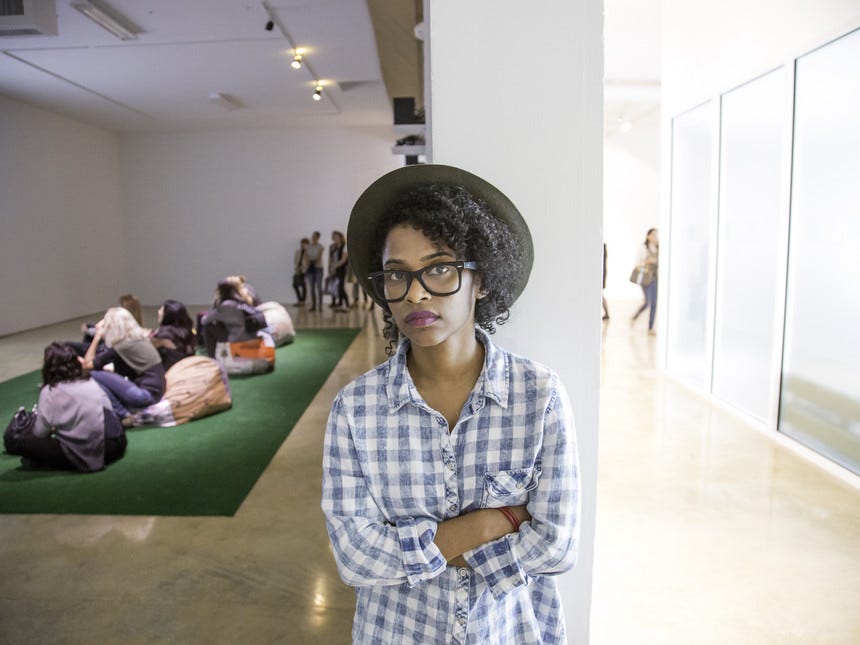
Even smaller than Monroeville but still on the NEA radar is York, Alabama, home to just under 3,000 residents, 80% of whom are African American. In York, funds found their way to The Coleman Center for the Arts (CCA), an arts organization that “uses art to foster positive social change, answer civic needs, build local pride, and use creativity for community problem solving.” Founded in 1985, the Coleman Center has been working for decades on facilitating partnerships between the community and artists of a range of disciplines.
This NEA funding in particular allowed for an artist residency with contemporary artist Tameka Norris (aka Meka Jean), a mixed media and performing artist who will spend a year in York exploring her own rural Southern roots. Norris will film her experience, made available during the residency as short vignettes on small screens throughout York. The project, “Somewhere is Here: A Town Called York,” will culminate in a collaborative narrative film.
Our last organization in Alabama is the Alabama Prison Arts and Education Project, or APAEP, for which Auburn University serves as fiscal sponsor. Founded 2002, APAEP has received NEA funding for most of its history — funding this critical project is absolutely reliant on.
Alabama has a prison population of around 50,000 people, unsurprisingly disproportionately weighted towards men and women of color, with African Americans making up 54%, vs. only 26% of the state’s population.
Working in collaboration with the Alabama Department of Corrections, the organization offers college level crosses across all curricular areas. This grant cycle, in particular, supported APAEP’s provision of visual arts workshops taught by emerging and established artists for incarcerated men and women in multiple facilities around the state. A touring exhibition of the work would then be presented, accompanied by an anthology of student produced creative works. APAEP has been creating anthologies of student work for some time, some of which are available online.
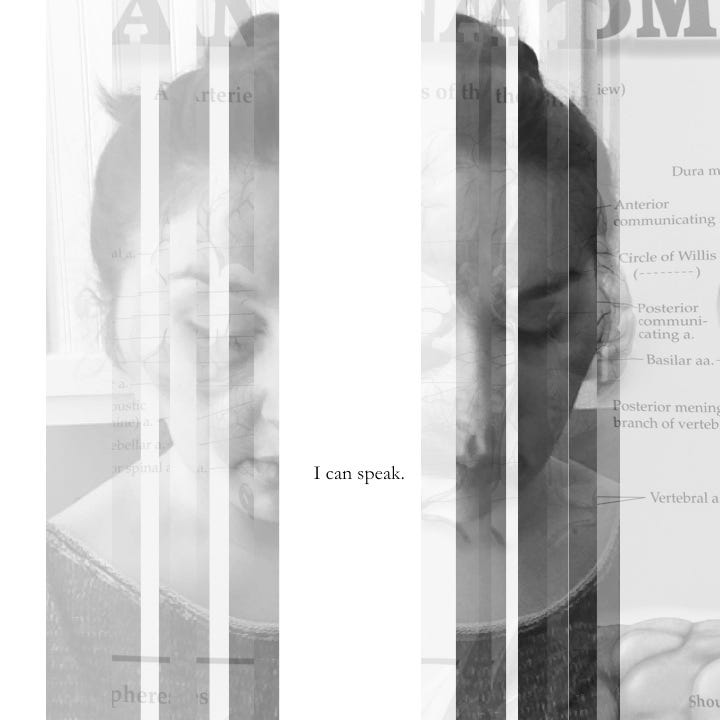
But the Alabama story isn’t over, because in this cycle we also have a lifechanging fellowship grant, still available for Literature, awarded to poet Emma Bolden, from Pelham, Alabama.
This was Bolden’s 8th time applying for an NEA fellowship, in the midst of what she calls a “dumpster fire” of a year (for reasons familiar to many of us). On her website, she describes winning the grant as a “surreal,” amazing experience that helped her find hope for the first time in a long time.
The poet’s first full-length collection, Maleficae, is a book-length series of poems about the witch trials in early modern Europe. Maleficae was a finalist for the 42 Miles Press Poetry Prize and the Cleveland State University Press First Book Award as well as a semi-finalist for the Perugia Press Prize and the Brittingham and Felix Pollak Prizes; it was published by GenPop Books in 2013. Her second full-length collection, medi(t)ations, is a book-length lyric essay/poetry hybrid published by Noctuary Press in 2016. She is also the author of three chapbooks of poetry — How to Recognize a Lady (part of Edge by Edge, Toadlily Press), The Sad Epistles (Dancing Girl Press) and This Is Our Hollywood (The Chapbook) — and a nonfiction chapbook, Geography V (Winged City Press). She currently serves as Senior Reviews Editor at Tupelo Quarterly.
NEA Fellowship winners across the board describe the opportunity to write, funded by this windfall, as an unparalleled experience that changed the course of their life. It is one of the few remaining individual fellowships of this type remaining from the federal government supporting the arts.
As an artist and educator, as well as a citizen (and especially as one who has spent the large portion of my life with extremely limited resources), I can say without reservation that I owe my growth and evolution not only as a creator but as a thoughtful, engaged human being to the types of organizations listed here — to the types of organizations that strive to survive in all our states. It’s a really exciting thing to learn about what’s happening far from home — it’s heartening, ironically, given that the impetus to this project was the threat to cut the funding for these life-giving works.
I hope you’ll continue to journey with me! And if in the interim, you’re curious to know more about what’s being funded in your state (or anywhere across the US!) this information is publicly available here, on the NEA website. Next stop, Arkansas!
An invitation to friends and readers: this is a probono project, on top of a busy publishing schedule and my teaching job. That said: if you’re interesting in participating, I’d be more than happy to have you join me. If you’d like to pick a state and write on its grantees, please be in touch! I’d also gladly accept support for the project (and many others) via The Operating System’s new Patreon site.
Right to Bear Arts :: 50 States of NEA :: ALABAMA was originally published in DrunkenBoat on Medium, where people are continuing the conversation by highlighting and responding to this story.
